Mahmoud Katta1, Stelian-Mihai-Sever Petrescu2, Felicia Ileana Mărășescu2, Mihaela Jana Țuculină3*, Liliana Eugenia Cuțui4, Ruxandra Voinea-Georgescu5, Horia Mocanu5, Cristian Niky Cumpătă5, Andreea Gabriela Nicola6, Ionela Teodora Dascălu2
1PhD Student, Faculty of Dentistry, University of Medicine and Pharmacy of Craiova, 2-4 Petru Rareș Str., 200349, Craiova, Romania
2Department of Orthodontics, Faculty of Dentistry, University of Medicine and Pharmacy of Craiova, 2-4 Petru Rareș Str., 200349, Craiova, Romania
3Department of Endodontics, Faculty of Dentistry, University of Medicine and Pharmacy of Craiova, 2-4 Petru Rareș Str., 200349, Craiova, Romania
4Student Polyclinic, 107 H Calea București Str., 200478, Craiova, Romania
5University Titu Maiorescu of Bucharest, Faculty of Dental Medicine, 67A Gheorghe Petrascu Str., 031593, Bucharest, Romania
6Department of Oro-Dental Prevention, Faculty of Dental Medicine, University of Medicine and Pharmacy of Craiova, 200349 Craiova, Romania
*Correspondence author: Mihaela Jana Țuculină, Department of Endodontics, Faculty of Dentistry, University of Medicine and Pharmacy of Craiova, 2-4 Petru Rareș Str., 200349, Craiova, Romania and Stelian-Mihai-Sever Petrescu, Department of Orthodontics, Faculty of Dentistry, University of Medicine and Pharmacy of Craiova, 2-4 Petru Rareș Str., 200349, Craiova, Romania; Email: [email protected]; [email protected]
Published Date: 22-02-2023
Copyright© 2023 by Țuculină MJ, et al. All rights reserved. This is an open access article distributed under the terms of the Creative Commons Attribution License, which permits unrestricted use, distribution, and reproduction in any medium, provided the original author and source are credited.
Abstract
Objective: The aim of this study was to determine the prevalence of periodontal changes in children with malocclusions from Olt and Gorj Counties, Romania.
Materials and Method: In this research direction, we took into account: gender (male and female), the place of origin (rural and urban), the classes of maloccusions (according to Angle’s classification) and the existence or not of fixed orthodontic appliances. The study included a number of 4508 children, aged between 6 and 14 years. The data were collected from December 2019 to February 2020, based on the project „Educație pentru sănătate orală. Cercetări privind anomaliile dento-maxilare și leziunile odonto-parodontale la școlarii din Oltenia”, in which several institutions were involved. In order to perform complex statistical tests (Z-test for proportions, Chi-squared test), commands from the XLSTAT module were used. The study was interrupted before it was completed due to the COVID-19 pandemic outbreak.
Results: We noted that there is a highly significant difference (p<0.001) between the presence of periodontal changes in children treated with fixed orthodontic appliances (88.36%), respectively without orthodontic treatments (12.37%). Also, we found that there is a highly significant difference (p<0.001) between the presence of changes in the periodontium in children with malocclusions (29.9%), respectively without malocclusions (4.92%).
Conclusion: After this research, we concluded that are differences between the presence of periodontal changes in children undergoing treatment with fixed orthodontic appliances, respectively without orthodontic treatments and also between the presence of periodontal changes in children with maloccusions, respectively without malocclusions.
Keywords: Malocclusion; Prevalence; Periodontal Changes; Fixed Orthodontic Treatment
Introduction
Malocclusions are the result of the adaptability of the dento-maxillary apparatus to numerous etiological factors, causing the deterioration of dento-facial aesthetics and greater susceptibility to trauma and periodontal disease [1].
It is clear that we are witnessing an increase in the prevalence of malocclusions globally. According to data provided by the World Health Organization, malocclusions are the third most common pathology of the dento-maxillary apparatus, after dental caries and periodontal disease [2-5]. These can be caused by genetic mutations and racial crosses or morphologically different anthropological typologies. All these can be accentuated by increasingly harmful environmental factors due to industrialization in the last decades [6].
Along with the prevalence of malocclusions, periodontal changes have also increased, either existing within these pathologies, or appearing or worsening during orthodontic treatment. Therapy with fixed orthodontic appliances, by the retentive areas of their components, favors the accumulation of bacterial plaque and makes it difficult to remove it, both through self-cleaning and through oral hygiene aids [7-10]. Also, the long duration of this treatment can lead to periodontal damage [11-14].
The aim of this study was to determine the prevalence of periodontal changes in children with malocclusions from Olt and Gorj Counties, Romania. In this research direction, we took into account: gender (male and female), the place of origin (rural and urban), the classes of malocclusions (according to Angle’s classification) and the existence or not of fixed orthodontic appliances. At the same time, we compared the results of my study with others from the specialized literature.
Materials and Methodology
The study was carried out within the research project Educație pentru sănătate orală. Cercetări privind anomaliile dento-maxilare și leziunile odonto-parodontale la școlarii din Oltenia”, being approved by the Ethics Committee of the University of Medicine and Pharmacy in Craiova.
The research was carried out through a partnership between: Active Yourope Association, 8 schools from Olt and Gorj counties and related County School Inspectorates. For the two counties included in the study, two schools from the rural environment and two from the urban environment were selected. After obtaining the approvals from the County School Inspectorates, the general directors of the schools involved in the project also gave their consent. Later on the teachers were informed and the informed consent of the parents or relatives of the participating children was also obtained.
Criteria For The Inclusion In The Study
In order to fulfil the objectives, we proposed the following criteria for the inclusion in the study:
- Children’s age: 6-14 years (including those of legal age)
- The children must be students of the chosen educational units
- Acknowledgment and signing of the informed consent by a parent or relative
- Children’s verbal consent for examination
- Voluntary participation and cooperation of children
Criteria For The Exclusion From The Study
We also proposed the following criteria for the exclusion from the study:
- Children who do not fall into the age range of 6-14 years old
- Children who did not receive informed consent from one of their parents or guardians
- Uncooperative children
After applying the criteria, we obtained the study group, consisting of a number of 4508 children, aged between 6 and 14 years, coming from:
- Olt County:
- rural environment: Fărcaşele High School and “Nicolae Marineanu” Cezieni High School
- urban environment: High School No. 2 from Caracal and “Nicolae Titulescu” Secondary School from Caracal
- Gorj County:
- rural environment: Tânțareni Secondary School and Capu Dealului Secondary School
- urban environment: “Spiru Haret” National College from Târgu Jiu and “Constantin Săvoiu” High School Târgu Jiu
Examining Children and Centralizing The Obtained Data
The examination of the children was carried out in the classrooms, with the help of natural light. The clinical examination was performed by simply visualizing the oral cavity, the child being seated on a chair in front of the doctor. No dental consultation instruments were used during the examination. We recorded the information obtained in a file, which included: age, gender, place of origin, the existence or not of fixed orthodontic appliances and occlusion and malocclusion diagnoses.
We used Angle’s classification, being the first to appear and the most used even today. To record and analyze the data, we used the Microsoft Excel program, in which we recorded the following parameters: gender, place of origin, classes of malocclusions (according to Angle’s classification) and the existence or not of fixed orthodontic appliances.
Statistical-Mathematical Data Processing
The Microsoft Excel program (Microsoft Corporation) was used for data processing, together with the XLSTAT suite for MS Excel (Addinsoft SARL). The obtained information was stored in Microsoft Excel files, and then processed statistically, in order to analyse the relationships between the clinical and paraclinical data of the patients.
Secondary data processing – descriptive analysis of the batch according to different parameters, their graphic representation was carried out with the Excel program, using the Pivot Tables, Functions-Statistical, Chart commands and the Data Analysis module. In order to perform complex statistical tests (Z-test for proportions, Chi-squared), commands from the XLSTAT module were used.
The Z-test for proportions is used to investigate the statistical significance of the difference between a theoretical frequency f (in a population) and an observed frequency p on a representative sample, for a qualitative, binary variable, or in order to compare frequencies calculated on two randomized and independent samples, drawn from two different populations. The test is correctly applied if the number n of the sample observations is sufficiently large: n·p, n·(1-p)>10 or if the two samples have a sufficiently large number of subjects n1, n2 >30 [15,16].
In the case of parameters that are not represented by numerical, continuous or discrete data, we cannot calculate the traditional correlation coefficients previously listed. In the case of ordinal or nominal data, we must resort to tests that analyse the incidence (contingency) tables generated by the cross tabulation of some pairs of factors, in order to identify the links between the categories of those variables.
The Chi-squared test is a statistical test that shows whether there is any relationship (mutual influence) between two factors. It was used to interpret the incidence tables generated by the cross tabulation of the pairs of factors tracked in this study. We used the following interpretation of the p values, provided directly by the program with which the statistical processing of the data is carried out, by applying the above test: p < 0.05 (significant result); p < 0.01 (significant result); p < 0.001 (highly significant result); p > 0.05 (insignificant result) [1,17].
Results
General Characteristics of The Studied Group
The study group contains a number of 4508 children (studying at the 8 schools included in the research project), aged between 6 and 14 years. Among them, 2376 (52.72%) were girls and 2132 (47.28%) were boys (Fig. 1).

Figure 1: Distribution of the studied group by gender.
From the total number of children included in the study, 3267 (72.48%) came from the urban environment and 1241 (27.52%) from the rural environment (Fig. 2).

Figure 2: Distribution of the studied lot according to the place of origin.
From the total of 4509 children included in the study, 1716 (38.08%) presented malocclusions (Fig. 3).

Figure 3: Prevalence of malocclusions.
Distribution of Malocclusions and Periodontal Changes
We found that Angle class I maloccusions are the most numerous (20.27%), the least common being class III/1 (0.24%) (Fig. 4).

Figure 4: Distribution of malocclusions according to Angle’s classification.
Angle’s classification | Total | With malocclusions and periodontal changes | With malocclusions and without periodontal changes | Without malocclusions and with periodontal changes | Without maloccusions and no periodontal changes |
Without malocclusions | 2792 61.92% | – | – | 137 100% | 2655 100% |
I | 913 20.27% | 277 53.99% | 636 52.86% | – | – |
II/1 | 669 14.83% | 197 38.4% | 472 39.23% | – | – |
II/2 | 98 2.17% | 29 5.65% | 69 5.73% | – | – |
III/1 | 11 0.24% | 3 0.58% | 8 0.66% | – | – |
III/2 | 25 0.55% | 7 1.36% | 18 1.49% | – | – |
With malocclusions | 1716 38.08% | 513 100% | 1203 100% | – | – |
Total | 4508 | 513 | 1203 | 137 | 2655 |
Table 1: Distribution of malocclusions according to Angle’s classification and the presence/absence of periodontal changes.
Through analysing the relationship between the presence of fixed orthodontic appliances and the appearance of periodontal changes, we found that there is a highly significant difference (p<0.001 according to the Chi-squared test) between the presence of periodontal changes in children undergoing treatment with fixed orthodontic appliances (88.36%), respectively without orthodontic treatments (12.37%) (Fig. 5).

Figure 5: Distribution of periodontal changes according to the presence/absence of fixed orthodontic appliances.
Through analysing the relationship between the presence of malocclusions and the existence of changes in the superficial periodontium, we found that there is a highly significant difference (p<0.001 according to the Chi-squared test) between the presence of changes in the periodontium in children with malocclusions (29.9%), respectively without malocclusions (4.92%) (Fig. 6).

Figure 6: Distribution of periodontal changes according to the presence/absence of malocclusions.
Through analysing the relationship between the gender of the children participating in the study and the presence of periodontal changes, we noted that there is no significant difference between boys and girls (p=0.563>0.05 according to the Chi-squared test). The presence of periodontal changes in girls (20.79%) is only slightly higher than in boys (19.91%) (Fig. 7).

Figure. 7: Distribution of periodontal changes by gender.
Evaluating the relationship between the place of origin of the children included in the study group and the presence of changes in the superficial periodontium, we noticed that there is no significant difference between children from rural areas and those from urban areas (p=0.127>0.05 according to the Chi-squared test). The presence of periodontal changes in schoolchildren from urban areas (21.09%) is slightly higher than in those from rural areas (18.48%) (Fig. 8).

Figure 8: Distribution of changes in the superficial periodontium depending on the place of origin.
Discussion
In the specialized literature, there are few data regarding the prevalence of periodontal changes in patients with malocclusions.
The results of my study include information on the prevalence of periodontal changes in subjects with malocclusions (both in the presence and absence of fixed orthodontic appliance therapy).
In research conducted in South Korea between 2012 and 2014, on a number of 14,693 people aged over 19 years old, a lower prevalence of marginal periodontal changes was revealed in subjects undergoing orthodontic treatment (9%) compared to those who do not present such treatments (44%). The adults included in the study who are not undergoing orthodontic treatment presented a higher number of systemic diseases, such as diabetes, hypertension and metabolic diseases [18]. Through a comparison with this study, we found that the research results from South Korea differ.
Another study in India covering a number of 90 subjects (44 males and 46 females) aged 12 to 18 years undergoing orthodontic therapy indicated a 100% prevalence of periodontal changes [19]. The results of this research on the prevalence of periodontal changes occurring in patients wearing fixed orthodontic appliances are similar to those of the study conducted in India.
Another similar study was conducted in Turkey on a number of 534 children aged 12 to 14 years. The authors cocluded that periodontal status is associated with anterior segment crowding and that the assessment of the orthodontic treatment needs should be based not only on the severity of the malocclusion, but also on the dentition period and the age group [20].
After a study carried out in Saudi Arabia on a number of 410 subjects, the authors found that 314 patients had Class I, 57 had Class II (division I), 25 had Class II (division II) and 14 had Class III malocclusions. The majority had a plaque index (PI) and gingival index (GI) of score 2 (74.1% and 83.7%, respectively). Also, they demonstrated a relationship between malocclusions and presence of periodontal disease in patients seeking orthodontic treatment. Therefore, careful evaluation of gingival and oral hygiene along should be considered [21].
A limitation of this study is that it only included patients over a 3-month duration, because of the COVID-19 pandemic outbreak. Results of this study should be interpreted with caution, as various confounding factors for periodontal disease such as socioeconomic factors, diet, oral hygiene tools used and its frequency, frequency of dental visits and family history of malocclusions and periodontal disease have not been adjusted and these could possibly influence the prevalence and severity of malocclusions and periodontal disease.
Conclusion
We found the highest prevalence of changes in the superficial periodontium in children with Angle Class I malocclusions. We identified the lowest prevalence of periodontal changes in schoolchildren with class III/1 malocclusions. There is a highly significant difference between the presence of periodontal changes in children undergoing treatment with fixed orthodontic appliances, respectively without orthodontic treatments. There is a highly significant difference between the presence of periodontal changes in children with maloccusions, respectively without malocclusions. Further studies involving large populations are necessary, which requires increased attention regarding to prevent maloclussions and periodontal disease.
Acknowledgment
All the authors equally contributed to the drawing up of the present paper.
Conflict of Interest
The authors have no conflict of interest to declare.
References
- Petrescu SMS, Țuculină JM, Georgescu D, Mărășescu FI, Manolea HO, Țîrcă T, et al. Epidemiological study of malocclusions in schoolchildren between 6 and 14 years old from Gorj County, Romania. Rom J Oral Rehabil. 2021;13(3):92-102.
- Brito DI, Dias PF, Gleiser R. Prevalence of malocclusion in children aged 9 to 12 years old in the city of Nova Friburgo, Rio de Janeiro State, Brazil. Revista Dental Press de Ortodontia e Ortopedia Facial. 2009;14(6):118-24.
- Dos Santos RR, Nayme JG, Garbin AJ, Saliba N, Garbin CA, Moimaz SA. Prevalence of malocclusion and related oral habits in 5-to 6-year-old children. Oral Health Prev Dent. 2012;10:311-8.
- Singh VP, Sharma A. Epidemiology of malocclusion and assessment of orthodontic treatment need for Nepalese children. Int Sch Res Notices. 2014;2014:768357.
- Guo L, Feng Y, Guo HG, Liu BW, Zhang Y. Consequences of orthodontic treatment in malocclusion patients clinical and microbial effects in adults and children. BMC Oral Health. 2016;16(1):112.
- Firu P. Introducere la studiul anomaliilor dento-maxilare. Ed. Academiei Republicii Socialiste România. 1981.
- Moyer RE. Handbook of Orthodontics. 4th Year Book Medical Publishers. 1988.
- Zachrisson BU, Zachrisson S. Caries incidence and oral hygiene during orthodontic treatment. Scand J Dent Res. 1971;79(6):394-401.
- Ogaard B, Rølla G, Arends J. Orthodontic appliances and enamel demineralization. Part 1. Lession Development. Am J Orthod Dentofacial Orthop. 1988;94(1):68-73.
- Årtun J, Brobakken BO. Prevalence of carious white spots after orthodontic treatment with multibonded appliances. Eur J Orthod. 1986;8(4):229-34.
- Shaw WC, Addy M, Ray C. Dental and social effects of malocclusion and effectiveness of orthodontic treatment: A review. Community Dent Oral Epidemiol. 1980;8(1):36-45.
- Navabi N, Farnudi H, Rafiei H. Orthodontic treatment and the oral health-related quality of life of patients. J Dent. 2012;9(3):247-54.
- Gwinnett AJ, Ceen RF. Plaque distribution on bonded brackets: a scanning microscope study. Am J Orthod. 1979;75(6):667-77.
- Nalcaci R, Demirer S, Ozturk F. The relationship of orthodontic treatment needs with periodontal status, dental caries and sociodemographic factors. Scientific World J. 2012;2012:498012.
- Sujatha BK, Yavagal PC, Nagesh, Gomez MSS. Relationship Between malocclusion and temporomandibular disorders among 12-18-year-old adolescents in devangere city – a cross sectional survey. J Dent Res Rev. 2018;5(2):65-8.
- Tomina D, Buduru S, Dinu CM, Kui A, Dee C, Cosgarea R, et al. Incidence of malocclusion among young patiens with gingival recessions – a cross-sectional observational pilot study. Medicina. 2021;57(12):1316.
- Petrescu SMS, Dascălu IT, Țuculină MJ, Dăguci C, Mărășescu FI, Manolea HO, et al. Epidemiological study of malocclusions in schoolchildren between 6 and 14 years old from Olt County, Romania. Rom J Oral Rehabil. 2022;14(1):38-44.
- Sim HY, Kim HS, Jung DU, Lee H, Lee JW, Han K, et al. Association between orthodontic treatment and periodontal diseases: Results from a national survey. Angle Orthod. 2017;87(5):651-7.
- Nair RA, Jain J, Praveena J, Shashidhar K, Pooja MR, Shetty S. Incidence of dental caries and periodontal diseases among adolescents receiving orthodontic treatment in a dental institute in virajpet. J Evolution Med Dent Sci. 2021;10(16):1119-22.
- Öz E, Küçükeşmen Ç. Evaluation of the relationship between malocclusion and the periodontal health, caries, socio-economic status of children. Meandros Med Dent J. 2019;20:20-7.
- Javali MA, Betsy J, Al Thobaiti RSS, Alshahrani RA, Al Qahtani HAH. Relationship between malocclusion and periodontal disease in patients seeking orthodontic treatment in southwestern Saudi Arabia. Saudi J Med Sci. 2020;8(2):133-9.
Article Type
Data Article
Publication History
Received Date: 24-01-2023
Accepted Date: 15-02-2023
Published Date: 22-02-2023
Copyright© 2023 by Țuculină MJ, et al. All rights reserved. This is an open access article distributed under the terms of the Creative Commons Attribution License, which permits unrestricted use, distribution, and reproduction in any medium, provided the original author and source are credited.
Citation: Țuculină MJ, et al. Epidemiological Study of Periodontal Changes in Children with Malocclusions from Oltenia Region, Romania. J Dental Health Oral Res. 2023;4(1):1-9.
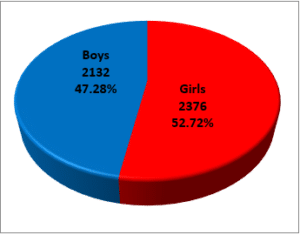
Figure 1: Distribution of the studied group by gender.
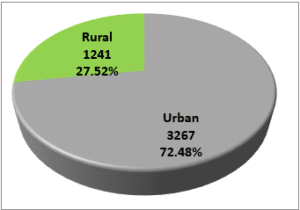
Figure 2: Distribution of the studied lot according to the place of origin.
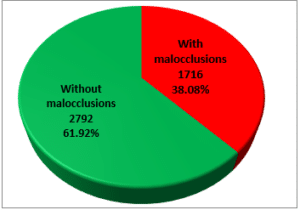
Figure 3: Prevalence of malocclusions.

Figure 4: Distribution of malocclusions according to Angle’s classification.
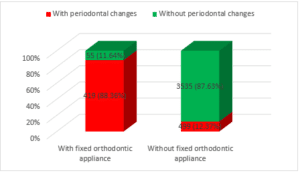
Figure 5: Distribution of periodontal changes according to the presence/absence of fixed orthodontic appliances.

Figure 6: Distribution of periodontal changes according to the presence/absence of malocclusions.
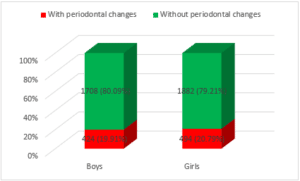
Figure. 7: Distribution of periodontal changes by gender.
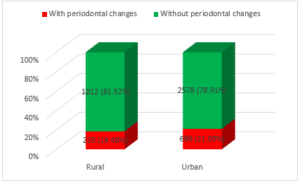
Figure 8: Distribution of changes in the superficial periodontium depending on the place of origin.


